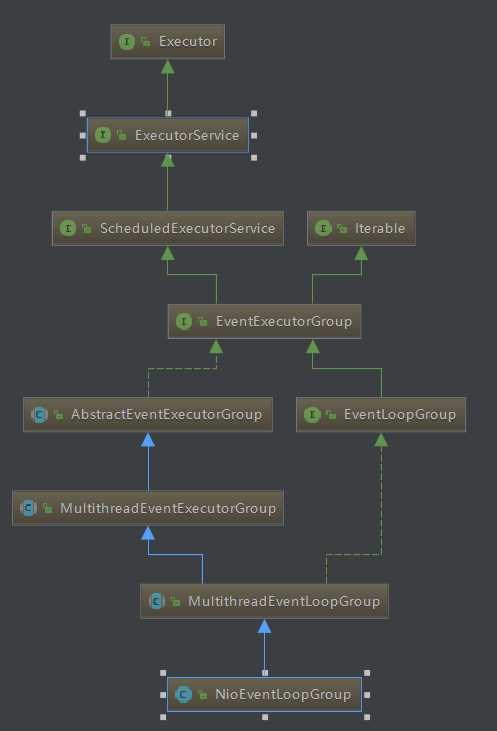标签:arguments 运算 down future get linked ace string false
0. NioEventLoopGroup简介
NioEventLoopGroup可以理解为一个线程池,内部维护了一组线程,每个线程负责处理多个Channel上的事件,而一个Channel只对应于一个线程,这样可以回避多线程下的数据同步问题。
1. NioEventLoopGroup类图

2. 构造方法
new NioEventLoopGroup()方法会调用到MultithreadEventLoopGroup的构造方法:
private static final int DEFAULT_EVENT_LOOP_THREADS; static { DEFAULT_EVENT_LOOP_THREADS = Math.max(1, SystemPropertyUtil.getInt( "io.netty.eventLoopThreads", NettyRuntime.availableProcessors() * 2));//默认值为系统core数的两倍 if (logger.isDebugEnabled()) { logger.debug("-Dio.netty.eventLoopThreads: {}", DEFAULT_EVENT_LOOP_THREADS); } } /** * @see MultithreadEventExecutorGroup#MultithreadEventExecutorGroup(int, Executor, Object...) */ protected MultithreadEventLoopGroup(int nThreads, Executor executor, Object... args) { super(nThreads == 0 ? DEFAULT_EVENT_LOOP_THREADS : nThreads, executor, args);//如果采用无参的构造函数,传入的nThreads变量为0,此时线程数会被设置为系统core数*2 }
然后会调用MultithreadEventExecutorGroup的构造方法:
/** * Create a new instance. * * @param nThreads the number of threads that will be used by this instance. * @param executor the Executor to use, or {@code null} if the default should be used. * @param chooserFactory the {@link EventExecutorChooserFactory} to use. * @param args arguments which will passed to each {@link #newChild(Executor, Object...)} call */ protected MultithreadEventExecutorGroup(int nThreads, Executor executor, EventExecutorChooserFactory chooserFactory, Object... args) { if (nThreads <= 0) { throw new IllegalArgumentException(String.format("nThreads: %d (expected: > 0)", nThreads)); } if (executor == null) { executor = new ThreadPerTaskExecutor(newDefaultThreadFactory()); } children = new EventExecutor[nThreads];//设定线程池大小 for (int i = 0; i < nThreads; i ++) { boolean success = false; try { children[i] = newChild(executor, args);//新建nThreads个子线程 success = true; } catch (Exception e) { // TODO: Think about if this is a good exception type throw new IllegalStateException("failed to create a child event loop", e); } finally { if (!success) {//如果新建子线程的过程中出错,则关闭所有子线程 for (int j = 0; j < i; j ++) { children[j].shutdownGracefully(); } for (int j = 0; j < i; j ++) { EventExecutor e = children[j]; try { while (!e.isTerminated()) { e.awaitTermination(Integer.MAX_VALUE, TimeUnit.SECONDS); } } catch (InterruptedException interrupted) { // Let the caller handle the interruption. Thread.currentThread().interrupt(); break; } } } } } chooser = chooserFactory.newChooser(children);//设定新任务的分配策略 final FutureListener<Object> terminationListener = new FutureListener<Object>() {//注册一些回调函数用于清理工作 @Override public void operationComplete(Future<Object> future) throws Exception { if (terminatedChildren.incrementAndGet() == children.length) { terminationFuture.setSuccess(null); } } }; for (EventExecutor e: children) { e.terminationFuture().addListener(terminationListener); } Set<EventExecutor> childrenSet = new LinkedHashSet<EventExecutor>(children.length); Collections.addAll(childrenSet, children); readonlyChildren = Collections.unmodifiableSet(childrenSet); }
其中比较重要的地方有两处:调用子类实现的newChild方法设置子线程,以及设置新任务的分配策略
先看一下NioEventLoopGroup中实现的newChild方法:
@Override protected EventLoop newChild(Executor executor, Object... args) throws Exception { return new NioEventLoop(this, executor, (SelectorProvider) args[0], ((SelectStrategyFactory) args[1]).newSelectStrategy(), (RejectedExecutionHandler) args[2]); }
很简单的新建一个NioEventLoop对象并返回,我们下一节会介绍NioEventLoop
而chooserFactory.newChooser最终会跳转到DefaultEventExecutorChooserFactory里:
@SuppressWarnings("unchecked")
@Override
public EventExecutorChooser newChooser(EventExecutor[] executors) {
if (isPowerOfTwo(executors.length)) {
return new PowerOfTwoEventExecutorChooser(executors);
} else {
return new GenericEventExecutorChooser(executors);
}
}
private static boolean isPowerOfTwo(int val) {
return (val & -val) == val;
}
虽然分配策略都是round-robin,但是在子线程的数量为2的幂时,可以用位运算来加速,效率很高。
Netty为了追求效率确实不择手段。
标签:arguments 运算 down future get linked ace string false
原文地址:http://www.cnblogs.com/stevenczp/p/7581940.html